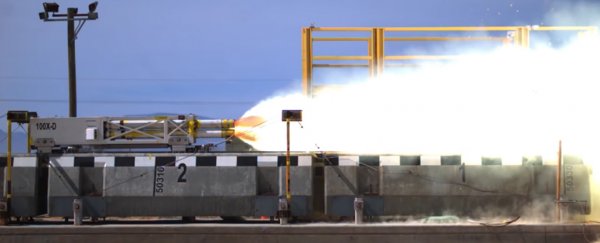Remember the maglev (magnetic levitation) tech that inspired some next-generation transport projects back in 2014? Well, the US Air Force just pushed it harder than it's ever been pushed before: up to 633 miles per hour (1,018.71 kilometres per hour), to be exact.
That speed was just reached by a custom-made sled during testing out at the Holloman Air Force Base in New Mexico. Though we're still a long way away from having a 600 mile-per-hour train, this record-breaking accomplishment means we're not that far off.
The world record attempt was handled by members of the 846th Test Squadron, who used a 2,100-foot (640-metre) track to carry the sled. The team actually beat its own previous record set two days earlier, which stood at 513 mph (825 km/h), while the fastest a maglev train has ever traveled is 366 mph (589 km/h).
The key to how magnetic levitation works is in the name: by levitating vehicles just above the surface of a track using magnetic fields, friction is vastly reduced, and less energy is lost. That energy instead is focussed on propelling a train or sled at eye-watering speeds that are only getting faster and faster.
"We use a very cold liquid helium to essentially levitate the sled on the superconducting magnets," explains Lt. Col. Shawn Morgenstern, while admitting that the US Air Force sled was "a developmental system" that's not necessarily going to be suitable for getting human beings between cities any time soon.
Three commercial maglev train systems are currently in operation in Japan, China, and South Korea, but more are in the works.
There are two different types of maglev technology: electromagnetic suspension (EMS), used in the commercial systems mentioned above, and electrodynamic suspension (EDS), which is only used on test tracks right now, though commercial versions are on the way.
A third approach - magnetodynamic suspension (MDS) - is still at the theoretical stage for now.
With EMS, the train rails are wrapped around the track, and the attraction between them overcomes gravity; on an EDS system, the train sits above the track, and a repelling magnetic force is used to lift it up instead.
Right now, EMS is regarded as the safer and more comfortable option, because it doesn't interfere with pacemakers or magnetic credit card strips, for example. It's also better at low speeds and can work on battery power if required.
The experts at the 846th Test Squadron use their own customised EDS maglev setup for testing purposes as they investigate potential military use. Next, the team wants to experiment using lighter materials for the sled to push the speed barrier even higher.
For us, the likely commuters, the accomplishment hints at a future where maglev trains usher us from place to place at a breakneck speeds, but only time will tell.
